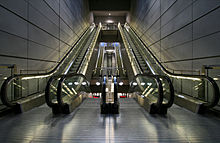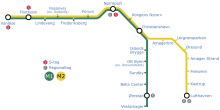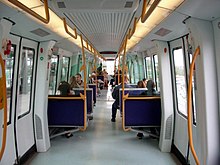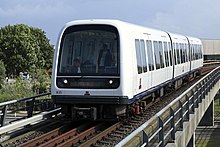Copenhagen Metro
The Copenhagen Metro is the underground railway of the Danish capital Copenhagen and the neighboring city of Frederiksberg . It was put into operation in 2002 and so far consists of four lines. All lines are driverless and fully automated . The metro is operated by the company Metro Service A / S , which is responsible for the track systems and train operations; it belongs to the Italian companies AnsaldoBreda , which was taken over by Hitachi Transportation Systems in 2015 , and Azienda Trasporti Milanesi (ATM).
The metro, together with the S-Bahn, is the main carrier of public transport in Copenhagen. While the latter mainly serves the metropolitan area, the metro is designed especially for traffic in the city center and in Frederiksberg as well as a connection to the new district of Ørestad and Copenhagen Airport (Danish: Københavns Lufthavn, Kastrup). The traction power is supplied via lateral busbars that are coated from below .
Line network
Lines
The network of the Copenhagen Metro consisted of two lines in the form of a Y-route until September 2019. These drive the section between Vanløse and Christianshavn together. After Christianshavn, the main route on the island of Amager is divided into two branches to Copenhagen Airport and Vestamager . In September 2019, an additional ring route ( Cityringen ) was opened, which is used by the newly created line M3. The north branch of the M4 line to Orientkaj has been in operation since March 28, 2020. The opening took place tacitly because of the COVID-19 pandemic .
| line | route | length | Journey time | Stations |
|---|---|---|---|---|
| Vanløse ↔ Vestamager (West- Amager ) | 13.7 km | 22 minutes | 15th | |
| Vanløse ↔ Lufthavnen ( Airport ) | 14.2 km | 24 minutes | 16 | |
| Ring line ( Cityringen ) | 15.5 km | 24 minutes | 17th | |
| Københavns Hovedbanegård ↔ Orientkaj | 8th |
In addition to the metro lines, the city also has a classic S-Bahn network called S-tog . S-Bahn and Metro together form the backbone of inner-city and regional local transport in the greater Copenhagen area. The metro is combined with the other local means of transport in Copenhagen to form a transport association that is divided into individual zones. There are transition options between the metro and S-Bahn at Nørreport , Flintholm and Vanløse stations and on the new ring line at Nørrebro and København H stations .
| Time | Vanløse - Christianshavn (M1, M2) |
Christianshavn - Vestamager (M1) |
Christianshavn - Lufthavnen (M2) |
Cityrings (M3) | København H - Orientkaj (M4) |
|---|---|---|---|---|---|
| 05-07 | 3 minutes | 6 minutes | 6 minutes | 4-5 minutes | 5 minutes |
| 07-09 | 2 minutes | 4 minutes | 4 minutes | 3 minutes | 3 minutes |
| 09-14 | 3 minutes | 6 minutes | 6 minutes | 4-5 minutes | 5 minutes |
| 14-18 | 2 minutes | 4 minutes | 4 minutes | 3 minutes | 3 minutes |
| 18-24 | 3 minutes | 6 minutes | 6 minutes | 4-5 minutes | 5 minutes |
| 01–07 after Fri – Sat |
7–8 minutes | 15 minutes | 15 minutes | 12 minutes | 12 minutes |
| 00–05 after Sun-Thu |
20 minutes | 20 minutes | 20 minutes | 6 minutes | 12 minutes |
The metro trains run around the clock. In the inner-city area, the line bundling of the M1 and M2 results in a train sequence of two to three minutes, on the two branches on Amager it takes four to six minutes. Trains run every 20 minutes between midnight and 5 a.m. on the nights from Monday to Friday, and every 15 minutes on weekend nights.
Passenger numbers
The number of passengers on the Copenhagen Metro is steadily increasing despite initial technical problems. Especially because of the possibility of taking bicycles with you, but also because of the extension of the route, the numbers could be increased by 70 percent compared to 2003 and 2004. Around three million passengers were carried in 2002, around 20 million in 2003, around 34 million in 2004, around 36 million in 2005 and finally 52 million in 2010. A new record was set in 2019 with 78.8 million passengers. Scenarios also envisage that 88 million passengers will be transported in 2030.
Stations
The main line consisted of 22 underground stations, nine of which are in the tunnel. Like the trains, they were designed according to a design by "Giugiaro Design" and should appear as timeless as possible. According to Robert Schwandl, this timelessness led to “[...] an exaggerated monotony [...]. Passengers can recognize their station just by the name on the station sign. ”The station signs in the street are“ Metro pillars ”. These five meter high pillars were designed by the Danish designer Knud Holscher and, in addition to an electronic trip display, have a red-brown “M” and the name of the respective station. The perforated grids of the columns are illuminated in color from the inside out at night. Since the opening of the Cityringen , the number of stations has increased to 37.
Every underground station should be as bright as possible and, as far as possible, manage without artificial light, which is usually perceived as annoying. As a result, numerous new design features have been included in the concept. The platform entrances are in shafts in the middle of the platform. In these there are escalators that lead in two or more sections from street level to the platform. There are also elevators as barrier-free access. The underground stations are marked on the surface by the glass pyramids, through which daylight penetrates to the platform, as there are no mezzanines with the exception of Frederiksberg station. This is reinforced by a number of prisms that also throw light into it. All tunnel stations are equipped with platform screen doors for safety ; they open flush with the door after the train has stopped. The underground stations are located both in a low elevation (about 5 to 8 meters) and in positions of up to 20 meters. At all stations there are elevators and escalators that lead directly to the surface, guidance systems for the blind are also available (tactile strips and braille).
The 13 above-ground stations, like the tunnel stations, are made entirely of glass, steel and concrete, and also have escalators and elevators. At these stations, platform screen doors were initially not used and a security system called the "Obstacle Detection System" was installed instead, which detects obstacles or people on the tracks and immediately initiates an emergency alarm if necessary. In order to increase operational reliability, all above-ground stations were retrofitted with platform screen doors by 2015 and the "Obstacle Detection System" replaced.
Almost all platforms are island platforms and are 60 meters long. The only exception is Nørreport, where the platform is 80 meters long due to the transition to the S-Bahn and long-distance train and its function as a central station. All stations are equipped with camera systems. Only at certain train stations are there so-called "Metro Stewards" who are responsible for looking after passengers and who should create a positive feeling of security.
history
prehistory
For decades it was considered necessary in Copenhagen to open up the city center by rail - the tram was discontinued in 1972, as in other Western European metropolises. At that time there was a plan to let the S-Bahn run through the center in a tunnel, as in Berlin , but the city administration soon gave up. The reasons for this were, on the one hand, the significantly larger tunnel profile on routes with overhead lines and thus a considerable financial outlay, and, on the other hand, the fact that the S-Bahn was designed for routes with large distances between stops and thus not for the city center. The connection should not only better open up the center in east-west relation, but also that with the steadily growing population of Amager .
Procurement and company formation
On June 24, 1992, the Folketing , the Danish parliament, passed a law to build the new Ørestad district on the southern island of Amager . On March 11, 1993, the Ørestadsselskabet (German: Ørestad Society) was founded with the aim of expanding the infrastructure. This company is 55% owned by the municipality of Copenhagen , the rest is owned by the Danish State , in the person of the Minister of Transport. Among other things, the company examined the construction of a new means of transport in order to connect the new district to the center at low cost. There were variants that provided for the reintroduction of the tram, but the introduction of a light rail was also included in the plans.
Ultimately, on January 3, 1996, the decision was made to build an automatically operated metro due to the best cost-benefit ratio. The contract was awarded to the consortium called Comet and the Italian company Ansaldo Trasporti and comprised a volume of around 2.94 billion Danish kroner (equivalent to around 394 million euros). Comet stands for Co penhagen Met ro Construction Group , which includes the companies Tarmac Construction of Great Britain with Bachy , Ilbau , SAE-International , Astaldi and Christiani & Nielsen . These are responsible for the construction of the elevated railway systems, tunnels and stations, while Ansaldo Trasporti is responsible for the automatic operating system and the trains. It was also Ansaldo Trasporti required to run the business for five years to be able to intervene quickly in initial technical difficulties.
The construction of the metro is divided into three or four phases. In phase 1, the basic network between Nørreport and the two branches to Vestamager and Lergravsparken should be built. Phase 2a consisted of the extension of the route from Nørreport S-Bahn station westwards via the city center to Frederiksberg . Phase 2b includes the extension of this route further west to Vanløse . Phase 3 includes the airport route and the Østamagerbahn from Lergravsparken to “ Københavns Lufthavn ”.
Previously, in February 1995, the construction of a local rail line to Frederiksberg was completed in cooperation with that municipality. For this purpose, a subsidiary called Frederiksbergbaneselskabet I / S was founded, which in turn is the client to the respective construction companies. The Ørestad company holds 30 percent of this company, and Frederiksberg, Denmark's fifth largest city by population, holds 70 percent. Today the section between Vanløse and Nørreport belongs to that route.
The same happened with the future route to Copenhagen- Kastrup Airport in September 1995. Here the Ørestad-Gesellschaft founded a subsidiary with the municipality of Copenhagen called Østamagerbaneselskabet I / S , which is also the client for the construction companies. The municipality holds 45% of the subsidiary and the Ørestad company 55%. The route between Lergravsparken and the airport is part of the Østamagerbahn.
Phase 1
Construction work for phase 1, i.e. the eleven-kilometer route between Nørreport in the center and Vestamager (route to Ørestad ) and Lergravsparken (route towards the airport), began in January 1997. This basic route with the two branches has eleven stations on six Kilometers of tunnel, three kilometers of elevated railway and two kilometers of heaped embankment. The tunnel was built using the New Austrian Tunneling Method (NÖT), the cut-and-cover method using various tunnel boring machines , with the fact that the Copenhagen soil mainly consists of limestone was decisive for the planning . All tunnel stations were built using the cover construction method. The tunnel diameter is 4.9 meters, one tunnel section weighs 3.13 tons. Half of the platform had to be closed for two years for the construction of a connecting tunnel for changing trains at Nørreport S-Bahn station. In order to be able to operate the new route, a total of 19 articulated wagons were ordered, which were delivered to the newly built Ørestad workshop.
First the metro to the new district was built and only then the various buildings were erected there, including a branch of the Copenhagen University, the Copenhagen Concert Hall (designed by the French architect Jean Nouvel ) and an IT school. The subway has a development function and thus attracts investors who buy the building land there and have it built on. The proceeds will in turn cover the construction costs of the new metro. There are plans to build two new stations north and south of Ørestad station , which would be called Ørestad Nord and Ørestad Syd . However, these are only implemented when there is a certain number of inhabitants.
The first route was inaugurated on October 19, 2002 by the Danish Queen Margrethe II . Almost 70,000 passengers, both from the city of Copenhagen and from home and abroad, visited the new means of transport on the opening weekend. The first commercial journeys began two days later every six minutes between Nørreport and Christianshavn ; the external routes to Lergravsparken and Vestamager were served every twelve minutes. With the approval of the Danish Railway Authority, the sequence of journeys could be reduced to four and a half minutes from December 2, 2002, and to three minutes from December 17.
Phase 2a and 2b
After the basic network of the Copenhagen Minimetro had been completed with phase 1, phase 2a had to be implemented with an extension towards Frederiksberg . In contrast to the first phase, the second construction phase is located exclusively in the tunnel, but also includes only two new train stations ( Forum and Frederiksberg ) over a distance of three kilometers. Until 2000, the Vanløse – Frederiksberg line was used by S-Bahn trains above ground. The trains ran from Klampenborg via what is now the northern part of the ring line to Vanløse switchback station and from there via the "Frederiksbergbane" to Frederiksberg terminus . Up to the tunnel portal at Hp Fasanvej, the planum of the Frederiksbergbane was used again for the underground, and the platform in Vanløse station was also built at the previous location. The connections to the S-Bahn network have been removed. The section between Nørreport via Forum to Frederiksberg was put into operation on May 29, 2003.
Phase 2b was realized that same year on October 12, 2003 and covers the Frederiksberg – Vanløse section . Stage 2b is 2.8 km long, about 700 meters of which run in the tunnel, the tunnel ramp is located just behind Solbjerg train station . The metro runs on an embankment for the remaining 2.1 km. In total, the line had three S-Bahn stations when it opened. The fourth, Flintholm , was only opened to traffic a few months later, as it was subsequently decided to use a tower station for the S-Bahn lines F (new ring line) and H (Frederikssundbahn) as well as the to replace the no transfer options in Valnøse Build Metro. The opening of this crossing station took place on January 24, 2004.
Phase 3 - Østamagerbanen (Lergravsparken - Airport)
In May 2001 phase 3 of the Copenhagen metro project was decided: The "Østamagerbanen" should connect Lergravsparken with the Copenhagen-Kastrup airport , which would create a second connection between the airport and the city center. The 4.2 km long route, of which four kilometers are on the embankment, should have five stations, all of which are above ground: Øresund , Amager Strand , Femøren , Kastrup and, as the terminus, Lufthavnen . The passenger forecasts for the individual train stations in 2002 were between 5300 ( Kastrup ) and 6500 passengers per day ( Lufthavnen ). A very low figure of 1400 people has only been forecast for the Amager Strand station . In 2010, 257,000 people are expected to use the 1.5 billion Danish kroner (around 200 million euros) route to the airport every day. Eight new units were ordered from Ansaldobreda for the new route , so that a total of 34 wagons will be in operation after this delivery. The extension of the route to the airport was opened on September 28, 2007, thus fulfilling the basic concept of the Copenhagen Metro. At the airport there is a transfer option to the Öresund Railway .
Phase 4 - Cityring (København H - Kongens Nytorv - Nørrebro - København H)
→ Main article: Cityringen
In the first three phases, the airport and the Ørestad urban development area on the island of Amager were linked to the center of Copenhagen. With this city ring, the accessibility of the city center by public transport should now be improved, where the last tram line was switched to bus operation as early as 1972. That is why the Danish traffic experts first proposed a metro ring in 1999 to connect the most important points in the city. A 15-kilometer line with 17 stations, including 15 new, was to run between the main train station, Kongens Nytorv , Østerport (east gate), the north of Copenhagen, the municipality of Frederiksberg and Tove Ditlevsen Plads. In January 2004 the Danish Ministry of Transport presented several options for routing. The most important point of discussion was whether the route should lead via the existing Forum or Frederiksberg metro station . On September 29, 2019, the ring route was officially opened with the new M3 line. The M4 line to Orientkaj has been branching from the Cityring since March 28, 2020.
New route projects
Continuation of phase 4 - Cityring (København H - Kongens Nytorv - Nørrebro - København H)
The M4 line branching off from the Cityring will go into operation in individual sections. The last section should reach Ny Ellebjerg by 2024. In the medium to long term, further lines branching off the ring line in the direction of Gladsaxe and Brønshøj are also to be built. The section from the Ring to Kongens Enghave / Sydhavn should be completed by 2024. Stations in Havneholmen, Enghave Brygge, Sluseholmen, Mozarts Plads and Ny Ellebjerg are to be created.
Trains
For the Copenhagen metro, the Italian company AnsaldoBreda built 19 newly developed articulated cars based on a design by Italdesign Giugiaro . The three-part cars, which can only be separated in the workshop, are 39 meters long and have 94 seats and 294 standing places. They weigh 52 tons and run on four bogies . The two middle ones are Jakob's bogies . The car bodies, which are made of an aluminum construction, are 2.65 meters wide. The maximum speed is 80 kilometers per hour, in Copenhagen an average speed of 37 km / h is reached. The ends of the units are equipped with BSI compact couplings with lateral contact attachments. A fourth car body could be added, but this would mean that the platform screen doors would have to be rebuilt in all tunnel stations. The driving voltage of 750 volts direct current is supplied via lateral busbars that are coated from below ; there are three current collectors on each side of the car. The track width corresponds to the usual standard track of 1435 mm.
The trains are driverless and run fully automatically, but in an emergency they can also be driven manually by the “Metro Stewards” present. Accordingly, instead of the driver's cab, there are only covered auxiliary cabs. The interior is, completely contrary to the station design, in the colors blue, white and yellow. The seats are arranged across the direction of travel in a 2 + 2 compartment. The inside of the trains is monitored by cameras. Before the trains leave, both an acoustic and an optical signal will sound. There is a "call point" at each of the twelve doors, which passengers can use to contact the control center in an emergency.
19 units were procured for the first phase, AnsaldoBreda delivered seven more for the second and another eight new trains were required for the third phase to Copenhagen Airport.
Ørestad workshop
All wagons are maintained and parked in the newly built Ørestad workshop. It is located behind the Vestamager station and has a smaller hall and a larger covered parking area. In addition to the workshop, the control center and the “General Headquarters” are located there. The whole complex is known as the "Control and Maintenance Center" (CMC).
The depot is divided into two parts. In one part, the washing, cleaning and parking systems are summarized, which are operated completely automatically, in the other part the wagons are repaired and the main inspections of the units, which are necessary every few years, are carried out. There is a test track east of the hall.
Additional information
literature
- Robert Schwandl: U-Bahn in Scandinavia - Stockholm, Oslo, Helsinki, København , Robert-Schwandl-Verlag, Berlin 2004, ISBN 3-936573-04-2
- Ulla Hanselmann: Der Tunnelblick , Die Zeit , No. 5, January 22, 2004
- Walter Johann Hinkel, Karlreiber, Gerhard Valenta, Helmut Liebsch: U-Bahns yesterday - today - tomorrow from 1863 to 2010 . Schmid-Verlag, Vienna 2004, ISBN 3-900607-44-3 (chapter "Copenhagen")
Web links
- Website of Metroselskabet I / S (Danish)
- Official website of the Ørestad Society ( Memento of January 1, 2006 in the Internet Archive )
- Description of the Copenhagen subway project in English ( memento of January 18, 2006 in the Internet Archive )
- The Copenhagen Metro at Urbanrail.net ( Memento from January 6, 2011 in the Internet Archive )
- Copenhagen Metro at public-transport.net
- Introduction to the Copenhagen Metro (English); approx. 570 kB ( Memento from June 7, 2007 in the Internet Archive )
- Routing of the future ring metro with two variants, status February 2005 (Danish); approx. 740 kB ( Memento from September 27, 2007 in the Internet Archive )
Individual evidence
- ↑ Official Metro Website ( Memento of April 3, 2008 in the Internet Archive ) - Værd at vide om Østamagerbanen (Danish)
- ↑ a b NORDHAVN FÅR METRO 28. MARTS. In: nordhavn-avis.dk. January 24, 2020, accessed March 29, 2020 (Danish).
- ↑ a b Ritzau: Nordhavn kobles på Københavns metronet i stilhed Grundet corona. In: jv.dk. Retrieved March 29, 2020 (Danish).
- ^ Annual report 2004 of the Ørestad Society (pdf) ( Memento of July 21, 2007 in the Internet Archive )
- ↑ Annual report 2010 of the Ørestad Society (pdf, Danish)
- ↑ Passenger Valley for M1 / M2. 78.8 million passagerer rejste med metroen i 2019. In: m.dk. Retrieved April 4, 2020 (Danish).
- ↑ Ulla Hanselmann: Der Tunnelblick , Die Zeit, January 22, 2004
- ↑ Robert Schwandl: subways in Scandinavia - Stockholm, Oslo, Helsinki, København. Page 68
- ↑ Metroens arkitektur ( Memento of December 6, 2008 in the Internet Archive ) on the official website of the Metro company (Danish)
- ↑ Metroens festdag , [Feast of the Metro], Berlingske Tidende 26 September, 2007
- ↑ https://jyllands-posten.dk/indland/ECE11646108/tag-med-rundt-i-cityringen/
- ^ Metro til Sydhavn. In: m.dk. Retrieved July 21, 2019 (Danish).











